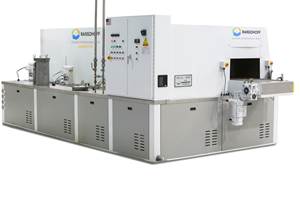Craftsman's Cribsheet: Three Contributors to Plating Problems on Steel Parts
Plating difficulties are invariably related to three potential contributors: inadequate cleaning, insufficient stock removal and features of the part being plated.
Plating difficulties are invariably related to three potential contributors: inadequate cleaning, insufficient stock removal and features of the part being plated.
The location of the plating problems on your parts gives you a key to determining the mechanism of failure:
- If the plating problems occur on both original bar surfaces as well as on as machined surfaces, inadequate cleaning is likely the cause.
- If the plating difficulties are only on the portion of your parts that are original barstock surface, insufficient stock removal is the most likely cause of the problem.
- If the plating is fine everywhere else on the part except near a particular feature, retention of contaminating fluid by a feature of the part is the likely cause.
Inadequate Cleaning
Inadequate cleaning describes the situation where, despite efforts to clean, some soil or contaminant remains, interfering with the plating.
- The cleaning method employed could just be insufficient to the task of cleaning: not enough time, agitation, and so on.
- It could be the incorrect cleaning process being used. Acidic cleaners do not remove oils or greases. Alkaline cleaners are needed to remove oils and greasy residues from steel parts. Solvents can be used to remove the bulk of oily residues.
If the plating problems are occurring on both original bar surfaces as well as on as machined surfaces, this is likely the cause.
Insufficient Stock Removal
Cold-drawn steel bars are now abrasive-cleaned by shot blasting with hardened steel shot. Shot blasting does not fully remove every bit of scale; some scale can remain in the bottom of small pits and depressions. This scale could interfere with the subsequent plating of parts by the following mechanisms:
- It can retain metalworking fluids or cleaner from the precleaning step and then release these during plating, causing localized reactions and staining.
- Because scale is an insulator, it will prevent electrical current flow at its location and thus mask or prevent the deposition and adhesion of the plate.
- It can create an air bubble by geometry as well as perhaps a hydrogen bubble if the bath is acidic. This bubble could form a mechanical barrier masking its location and preventing deposition/adhesion of the plate.
If the plating difficulties are only on the portion of your parts that are original bar stock surface, this is the most likely cause of the problem.
Part Geometry Features and Location
Many times, the design of the part can be the cause of the plating difficulties.
Features such as small-diameter holes, blind holes and recesses and grooves can retain fluids as well as create bubbles or support a meniscus. These can result in localized contamination, create staining and interference with deposition by providing a fluid or bubble barrier.
If the plating is fine everywhere else on the part except near a particular feature, retention of fluid by a feature of the part is the likely cause. Adding a wetting agent to reduce surface tension in a cleaner or a rinse can eliminate the problem.
If the machined surfaces’ plate is fine, but not those of the original bar surface nor the inside of a hole, it isn’t the steel. It’s one of the causes listed above.
There are other problems that can arise during plating that can be attributed to the plating process itself, but it has been my experience that these three categories cover most of the problems encountered when both the machine shop and the plater claim that there must be something wrong with the steel.
Related Content
Multisolvent 100 Vacuum Vapor Degreaser Provides Contactless Cleaning
PMTS 2023: With applications in the most demanding industrial sectors, the machine is especially useful for cleaning parts in the turning, precision mechanics, medical and aerospace industries.
Read MoreSita’s CleanoSpector Measures Part Cleanliness
PMTS 2023: Handheld measuring device checks for cleanliness of parts to assure product quality as well as prior to follow-up processes.
Read MorePMTS 2023 Product Preview: Parts Cleaning
Learn about some of the latest parts cleaning solutions that will be on display at PMTS 2023.
Read MoreOvercoming 3 Common Challenges With Automated Particle Counting
Facing difficulties while performing particle analysis is normal but should not be discouraging. Here are some ways to handle the most prevalent issues that can arise.
Read MoreRead Next
5 Aspects of PMTS I Appreciate
The three-day edition of the 2025 Precision Machining Technology Show kicks off at the start of April. I’ll be there, and here are some reasons why.
Read MoreDo You Have Single Points of Failure?
Plans need to be in place before a catastrophic event occurs.
Read MoreA Tooling Workshop Worth a Visit
Marubeni Citizen-Cincom’s tooling and accessory workshop offers a chance to learn more about ancillary devices that can boost machining efficiency and capability.
Read More





















